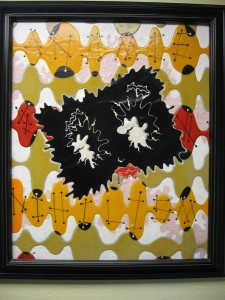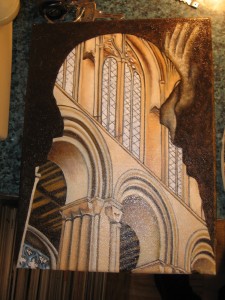Issue 28 11.20.13

Sources of Inspiration
By John Skaggs
I don’t always really know where the inspiration for my artwork comes from. The Latin word musa[1], “source of inspiration,” comes closest to describing the entity or entities that this form of animation, of which I can’t quite put my finger on, originates from. The inspiration is partially from me (prior experiences, etc.) but a larger “something else” is responsible for a large portion of it – and of course some of it comes from other people.[2] To paraphrase a principle of serendipity, I am the beneficiary of agreeable brainstorms that I am not always necessarily looking for. They seem to come from an unvisited place, like elaborate dreams about realistic places the dreamer has never consciously been to. As an artist, I feel compelled to express the various and assorted concepts that stir me the most. This multifaceted aspect at work in my thought processes contributes immensely to the somewhat eclectic nature of my art. The hope is always that my works can be inspirational to others and will in some way assist in the continual and phenomenal initiation of serendipity for whomever manages to receive it.
But the question is: does inspiration typically come to those who are not actively pursuing or contemplating new ideas? If inspiration works anything like insight, the answer is “yes.” Insight comes about through the multidimensional process of problem solving. Many inventors over the years have described insight as the proverbial “light going on” seemingly out of nowhere – but they also almost unanimously relate that the light usually does not go on immediately after periods of intense rumination and frustration. No, it magnificently happens mostly in a period of rest or sleep after they had temporarily given up on the specific problem and its aggravations. They “slept on it,” so to speak, for a duration. I see it as an interval of less-forced mental activity that puts less stress on the idea integration processes of the brain. The point I am making is that the inventive artist who, aside from conscious deliberation, often works out problems subconsciously and may not, for this reason, perceive the phenomenal source of their insight or inspiration readily. On the other hand, if inspiration is completely serendipitous, it implies that other spiritual forces are involved. I actually believe that it is a combination of both: 1.) If one seeks a solution to a problematic artistic endeavor they must willing to let the creative process run its course. 2.) If one has need of inspiration, they must be open to the reception of compatible things not always sought after (try that one on for size!). So creativity can be pre-conceived or unintentional. I would venture to say that the most effective artwork would be of the variety in which both dynamics are present and work in conjunction with each other.
Also, and putting as bluntly as possible, the creative process for any particular artist always proceeds out of a desire to “artificialize,” for lack of a better word, various aspects of conscious or subconscious existence. In modern and post-modern artwork, such as expressionism and surrealism, it is most likely to be a combination of both. Artworks can be highly inspirational, innovative, and real, but what they depict is obviously not reality itself. Not exclusive from such art movements such as minimalism; suprematism; abstract art; etc., which so-called experts falsely claim is pure or “unmasked,” all works of art are idealistic because they are intrinsically embodied in a cultural world view of some sort. The fundamental perception contained in the sociology of art is this: artistic expression tends to address or comment on social and cultural issues of the socioeconomic, religious and political worlds the artist lives in or comes into contact with. We are not completely controlled by culture, but we are not completely free of it either.
Inevitably, a purist artisan’s inspiration is also to express beliefs which are contained in his or her artwork to the viewing public for various social and cultural reasons, directly or indirectly.
To encapsulate, inspiration is not totally serendipitous and it is not totally idealistic, it is, rather, a combination of both in various degrees.“Insight” operates within the inspiration process and is the key or desired element of inspiration.
*** John Skaggs is a Bay Area native who currently resides in the Oakmore district of Oakland Ca. His paintings, drawings and sculptures are exhibited in various local venues and at Patten University where he teaches. Please contact at (510) 530-8411 or Pattenskag@aol.com.
Musing : to become absorbed in thought.
The consumption of large supplements of caffeine have also been known to initiate inspiration.

